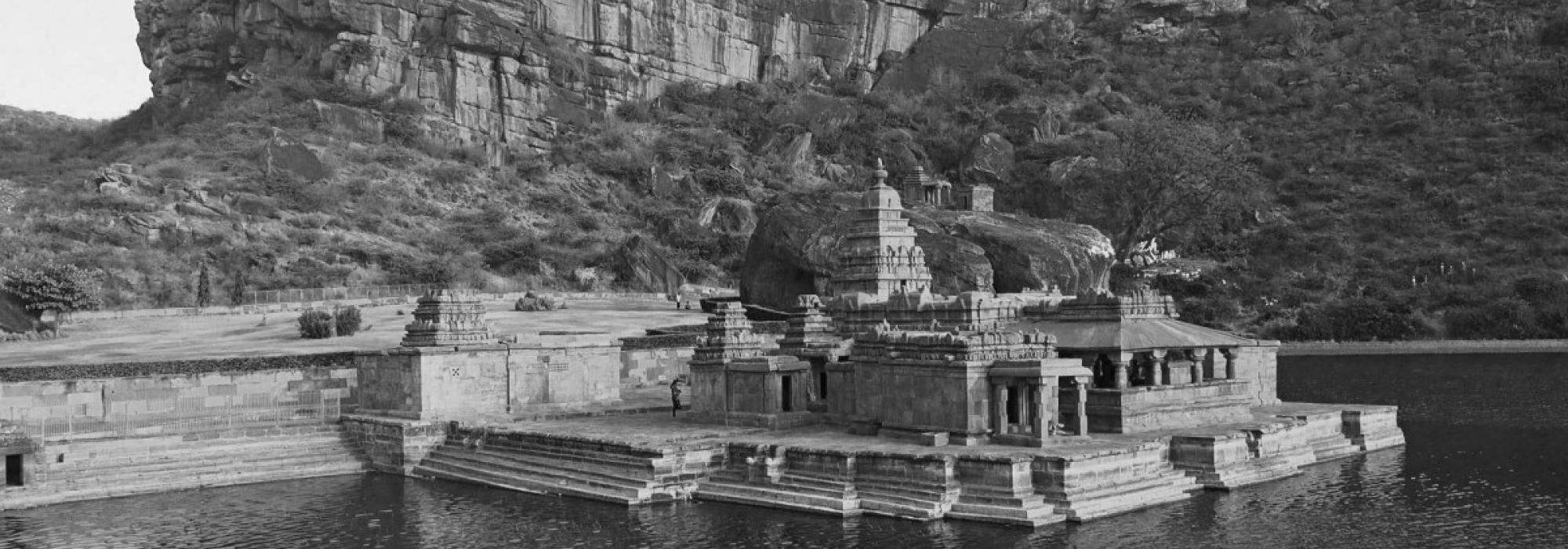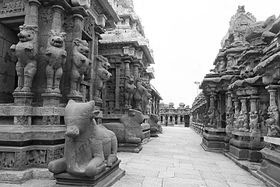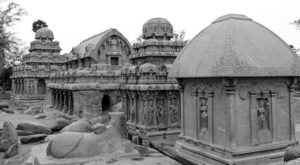An emperor as powerful as Pulakeshi II had to face numerous struggles during his last days. His brother “Kubja” [Short] Vishnuvardhana would repeatedly rise in rebellion, Pulakeshi would quell it and forgive him—this seemed to have become the norm. However, what we notice in each such instance is simply Pulakeshi’s weakness. The younger brother fully exploited his sibling’s sentimentality. Pulikeshi had four children. He justifiably displayed greater affection towards his third son, Vikramaditya. This naturally created jealousy among his other sons and they posed problems for him. In the past, Pulakeshi had defeated the Pallava king Mahendravarman with extraordinary valour. He had raided his capital, Kanchipuram and sounded the bugle of victory there. However, despite vanquishing his foe, Pulakeshi did not commit any atrocity on the city. Indeed, Pulakeshi’s magnanimity and cultural refinement is eternally praiseworthy. However, on his part, the defeated Mahendravarman was, quite obviously, seething. He therefore trained his son Narasimhavarman as a fighting machine meant to avenge Pulakeshi. Eventually, Narasimhavarman built up a massive force and attacked Vatapi (Badami) in the last days of Pulakeshi’s reign and emerged victorious. Indeed, he earned the title, “Vatapikondan” as a consequence of this victory. The epitome of exemplary architecture and sculpture, Mamallapuram (today’s Mahabalipuram) was built during Narasimhavarman’s reign. But such was the intensity of his vengeance that he literally set Vatapi on fire. Even today, the locals of Vatapi point to the traces of soot on the walls of the cave temples and claim that this heinous deed was committed by “Vatapikondan.” However, what I surmise is that he merely set fire to the city and not to the cave temples. When we look at the ASI (Archeological Survey of India) Museum in Badami, we can easily form a picture of how these temples would have been about eighty or hundred years ago: our unlettered and innocent villagers had converted these caves into cattle sheds and donkey-pens, and had built mud homes and cooked therein. That is the reason for the aforementioned traces of soot. The caves also sported excellent miniature paintings.
Indeed, there’s enough evidence to show that Narasimhavarman had set fire to the city and not to the cave temples. Besides, like the Chalukyas, the Pallavas too, were adherents of Sanatana Dharma. More specifically, both Pulakeshi and Narasimhavarman were equally devout Bhaktas of Vishnu. That doesn’t mean they were hostile towards Shaivas, Jains and Buddhists. The Pallava capital of Kanchipuram threw its door wide open to Shaivas, Shaktas, Vaishnavas, Jains and Buddhists, and patronized all Darshanas and Shastras. Kanchipuram was the playground of eminent poets and scholars such as Dandi, Dharmakeerthi, Sharadatanaya and others. Pallava Mahendravarman was himself a distinguished poet and author of Sanskrit comedies like Mattavilasaprahsana. Kanchi was a world-renowned center of culture and learning. In this light, spurious arguments on the lines of, “Hindus themselves have also destroyed their own temples; it’s not as if only Muslim kings have destroyed them,” advocated by self-proclaimed secular historians are utterly condemnable. When we examine Pulakeshi’s life, we clearly find the exact place where his spirit of Kshatra (valour) met with failure: in the attachment he had towards his family. Sri Rama’s attachment to his family was imbued with a sense of balance; but we see the extremes of this family attachment in the life of Pulakeshi. Indeed, this has a parallel in Dharmaraja’s (Yudhishtira) filial sentiment towards his evil cousins like Duryodhana. In the Ghoshayatra episode in the Mahabharata, Duryodhana who is badly beaten and captured by the Gandharvas is rescued by Arjuna and other Pandavas. In that situation, Bheema says: “the Gandharvas have done what we had to do.” But Dharmaraja does not agree and pardons Duryodhana. Likewise, Pulikeshi pardoned his younger brother, Kubja Vishnuvardhana who revolted thrice. He didn’t exhibit the requisite toughness towards his evil uncle at the appropriate time nor did he keep his wayward sons in check. All of these factors led to tragic outcomes. According to historical records, the uncle Mangalesha instigated Kubja Vishnuvardhana against Pulakeshi. Indeed, Pulakeshi could’ve completely avoided such a situation if he had acted decisively. He didn’t. Pained by such plotting, his grandmother died. But unable to let go of his attachment towards his sons, Pulakeshi tolerated their errors thereby leading to his own downfall. We find that the Gupta kings acted with a steely resolve and toughness in such matters. This is the precise difference between the Classical Age and subsequent periods. Chandragupta I opposed and bypassed a son named Kacha and coronated his other younger son, Samudragupta. Equally, Samudragupta’s son, Ramagupta ascended the throne only because he was the eldest and not because he was competent. In the end, he was killed by his younger brother Chandragupta Vikramaditya who faced mortal threat from Ramagupta himself: this was the extent of his incompetence. And it is for this reason that the Gupta Empire stood rock-solid and established all-round cultural and civilizational glory.
Weaknesses of Kshatriya Families
Pulakeshi’s son, Vikramaditya III had to struggle for thirteen long years to finally liberate Vatapi from the stranglehold of the Pallavas. Following this, he had to shift to Kalyana. Ever since, this dynasty became known as the Kalyana Chalukyas. The glory of Badami was irretrievably lost. In Ashoka, Kanishka and Harshavardhana, we observe the tragic consequences that occurred because of their weakness/partiality towards a religious sect that in turn, led to the extremes of non-violence and peace. In Pulakeshi, we note the same tragic consequence owing to his excessive fondness for his sons and failure to manage internecine feuds. In fact, we observe, yet again, the same weakness in Krishnadevaraya much later. Krishnadevaraya’s attachment towards his son reached such levels that he coronated[i] him when he was still a mere child. It also reached a level where Krishnadevaraya was blind to the skullduggeries of Aliya Ramaraya who paved the way for the destruction of the Vijayanagara Empire. Krishnadevaraya could have consolidated his power by strengthening Achyutaraya, his step-mother’s son, before his own son came of age. In fact, his minister, Thimmarasu had advised him precisely to do that. But then, why would such mighty Emperors admit to their weakness so easily? To be continued Translated by Hari Ravikumar and Sandeep Balakrishna
Notes:
[i] This in a way, resembles the phenomenon of child marriage that was pervasive in the society of medieval India. Whereas the rulers exhibited a lack of wisdom by coronating their progeny in childhood, their subjects displayed similar stupidity by pushing their kids into marriage years before these kids were aware of the facts of life. In much the same way, the heads of Mathas also encouraged childhood Sanyasa, which is highly unfortunate. All of these are totally opposed to the vision of our Rishis and led to great damage in hindsight.



















































